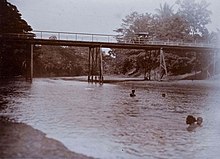Ci Durian
| Ci Durian | |
|---|---|

Bridge over the Cidurian 1915–26
|
|
|
Location in Java
|
|
| Country | Indonesia |
| Basin features | |
| Main source | Java |
| River mouth |
Tanara 6°01′27″S 106°24′42″E / 6.0242°S 106.4117°ECoordinates: 6°01′27″S 106°24′42″E / 6.0242°S 106.4117°E |
| Geonames | Ci Durian at GEOnet Names Server |
Ci Durian (Durian River), or Ci Kandi, is a river in the Banten province of western Java, Indonesia. It rises in the mountains to the south and flows north to the Java Sea. The delta of the river, now canalized, has long been used for rice paddies and for a period was also used for sugarcane plantations. Extensive irrigation works diverted water from the river into a canal system in the 1920s, but these works were not completed and suffered from neglect in the post-colonial era. Plans were made in the 1990s to rehabilitate the irrigation works and dam the river to provide water for industrial projects, with Dutch and Japanese assistance, but these were cancelled by the Indonesian government.
The Ci Durian rises on the slopes of the 1,929 metres (6,329 ft) high Mount Halimun and flows northward through the Banten region. It reaches the coast to the east of Kota Banten. The rivers in Banten, the westernmost province of Java, run roughly parallel to each other. The main ones are the Peteh, called the Banten on the lower reaches near the city of Kota Banten, the Ujung, which enters the sea at Pontang, the Durian, which enters the sea at Tanara, the Manceuri, and the Sadane, which rises in the mountainous region of Priyangan and in 1682 formed the border between the Dutch East India Company (VOC) territory and Batavia (modern Jakarta). The Durian, Manceuri and Sadane rivers flow through the Tangerang Plain. The rivers fan out into deltas near the coast. There are marshes between the mouth of the Durian at Tanara and the mouth of the Sadane.
The original inhabitants of the mouths of Ci Ujung, Ci Durian and Ci Banten rivers were Sundanese people. In 1682 there were paddy fields on the lower reaches of the Ujung and Durian. After 1700 sugar production in Banten was revived, mostly in the swampy Ci Durian delta, which had the water needed to grow sugarcane. This project was organized by the Chinese entrepreneur Limpeenko, a merchant who lived in Batavia and regularly visited the Banten Sultanate, bringing luxury fabrics for the Sultan's court. Limpeenko obtained a number of leases from the sultan in 1699. At this time the area at the mouth of the Durian was sparsely populated, with the original inhabitants living by fishing and some agriculture. Their way of life remained unchanged with the rise of sugar production. Newcomers such as Malays settled without permission in the area to work the sugar plantations, but the bulk of the labor force was Chinese from Batavia.
...
Wikipedia

